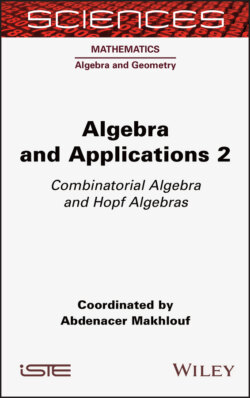Читать книгу Algebra and Applications 2 - Группа авторов - Страница 31
1.5.1. Manipulating algebraic operations
ОглавлениеAlgebra starts, in most cases, with some set E and some binary operation * : E × E → E. The set E shows some extra structure most of the time. Here, we will stick to the linear setting, where E is replaced by a vector space V (over some base field k), and * is bilinear, that is, a linear map from V ⊗ V into V. A second bilinear map is deduced from the first by permuting the entries:
[1.58]
It also makes sense to look at tri-, quadri- and multi-linear operations, that is, linear maps from V⊗n to V for any V. For example, it is very easy to produce 12 tri-linear maps starting with the bilinear map * by considering:
and the others deduced by permuting the three entries a, b and c. We could also introduce some tri- or multi-linear operations from scratch, that is, without deriving them from the bilinear operation *. We can even consider 1-ary and 0-ary operations, the latter being just distinguished elements of V. Note that there is a canonical 1-ary operation, namely, the identity map e : V → V. At this stage note that the symmetric group Sn obviously acts on the n-ary operations on the right by permuting the entries before composing them.
The bilinear operation * is not arbitrary in general: its properties determine the “type of algebra” considered. For example, V will be an associative or a Lie algebra if for any a, b, c ∈ V, we have respectively:
[1.59]
[1.60]
The concept of operad emerges when we try to rewrite such relations in terms of the operation * only, discarding the entries a, b, c . For example, the associativity axiom equation [1.59] informally expresses itself as follows: composing the operation * twice in two different ways gives the same result. Otherwise said:
[1.61]
The Lie algebra axioms (equation [1.60]), involving flip and circular permutations, are clearly rewritten as:
[1.62]
where τ is the flip (21) and σ is the circular permutation (231). The next section will give a precise meaning to these “partial compositions”, and we will end up giving the axioms of an operad, which is the natural framework in which equations like [1.61] and [1.62] make sense.
